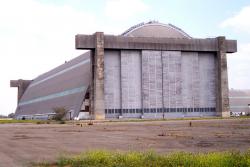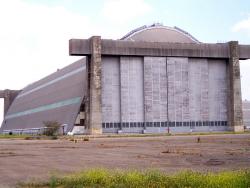All building materials were made fire-resistant to protect against incendiary bombing. Treatment involved a vacuum process of salt impregnation. During construction, high winds caused a partial collapse of some members. The ruined materials were piled for incineration, but would not burn; so the rubble was buried on site. Years later, a farmer leasing ground on the site plowed up some of the materials. They were reported to still be in good condition.
Navy

YearAdded:
Image Credit: Courtesy Wikipedia/Lordkinbote (CC BY-SA 2.0)Image Caption: Hangar No. 2Era_date_from: 1943
1993
Innovations

All building materials were made fire-resistant to protect against incendiary bombing. Treatment involved a vacuum process of salt impregnation. During construction, high winds caused a partial collapse of some members. The ruined materials were piled for incineration, but would not burn; so the…
Read More


